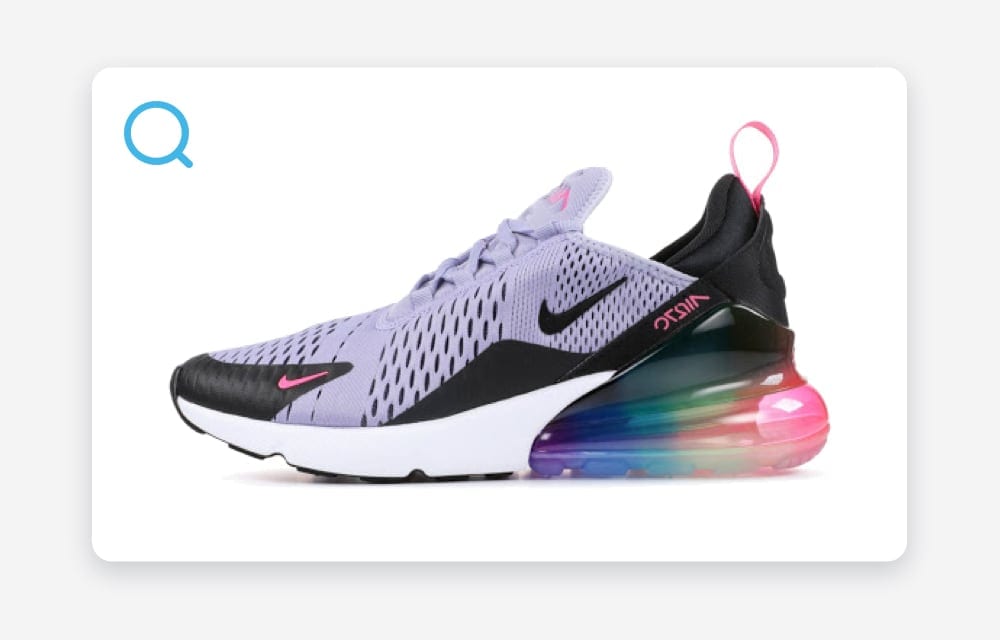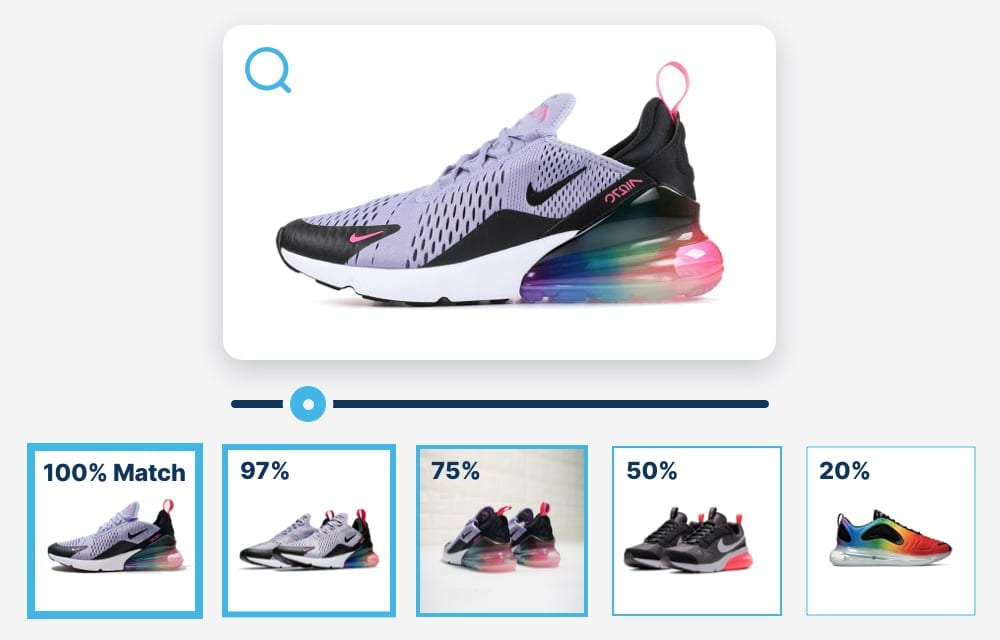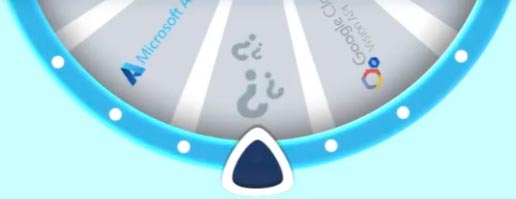Visual Search
Visual search is the next innovation that will decouple users from the reliance on keyboards and open a new world of opportunities. Feed in an input image and you have the ability to locate visually identical or similar images, or to discover products based on similar design traits. The applications are endless and exciting, especially when paired with mobile applications.

Flexibility in defining your visual search funnel
VISUA’s strength is our ability to deliver the most flexible solutions combined with our diverse technology offerings. Whether you need Visual Search to identify only exact matches or perhaps your application looks for visually similar images or products that’s doable. Want to search for similar design elements across different images? Absolutely. Ultimately, visual search is a funnel from original source image to discovered image/product. VISUA makes the implementation of that funnel simple and the discovery process fast and efficient.

VISUAL SEARCH FAQ
What is visual search, specifically related to computer vision?
Visual search is an implementation of computer vision (or Visual-AI) that enables users to search for visually identical or similar components by uploading or taking a picture, or even a video.
The API can be programmed with other visual-AI technologies like logo detection, object recognition and text detection to find exactly the same item or something which bears a resemblance by analysing colour, object type, logos and markings.
What elements can visual search be used on??
VISUA’s visual search is a highly flexible and customizable technology thanks to the ability to team it with our other API offerings.
With the exception of facial recognition or personal identification, our visual search can identify exact matches or visually similar images or products of any kind, from consumer products to landscapes and locations.
It can also be used to protect your product or artwork from unauthorized usage elsewhere online and it can identify known bad copies/elements in anti-phishing software.
How do I train the API to recognise the images or designs I am searching for??
With our Visual Search API, you can submit any volume of images to the engine to be visually indexed. These images can be queried for and studied via clustering or for training custom object models.
How long does it take to train a model?
The time required to train a new model varies depending on the object in question and use case. However, in most cases it takes a day or two to add a new object to the library.
I have created photography and artwork for my product and I want to detect unlicensed use of that imagery - is this possible?
Yes. This is the perfect use case for Visual Search. This compares the overall image itself to see how much it matches the source image.
Can I limit visual search to specific elements in an image or video?
Yes, you can use VISUA’s API to train your application to search for only specific elements. For example, if you want to create an app that can identify plants, you can train the API to recognise the key components of various species or if you want to detect a specific design element, you can do so.
Can I limit visual search to specific areas/zones in an image or video?
Absolutely! VISUA’s Visual Search API can be tasked to only look at specific areas, ignoring the rest of the image.
Does your visual search cope with images being cropped and re-sized?
Yes it does. Images can be cropped by up to XX% and still be matched against a source image.
Does your visual search only look for exact matches of an image or product/object?
No. We have a ‘Matching Control Filter’, which allows you to determine how close a match the test image must be to the source. This allows you to find derivative/look-a-like works that may not be exact copies, but still infringe on copyright/trademark.
Can I test your visual search technology?
Absolutely, we actively encourage and are very happy for our customers to benchmark our Visual-AI (Computer Vision) tech stack against other providers as we typically out-perform them.
However, as we don’t provide a one-size-fits-all system, we like to discuss your specific use case and requirements. Based on the outcome of that discussion, we then set up a live test using your own data. Once complete you receive the results and annotations in whatever format you need and we are available to discuss the specifics with you.
This is completely free, so simply get in touch to set this up.
How much does your visual search API usage cost?
In contrast to other computer vision solutions that provide a one-size-fits-all offering, VISUA does not have a standard price list. This is for a very logical reason – There are many factors and combinations of settings that define the final cost for each customer and our Visual-AI (Computer Vision) solutions are very flexible in this regard so that the final implementation not only meets each customer’s specific technical needs, but also budgetary needs.
For instance, these are just some of the factors that influence the final cost:
- The resolution of media to be processed
- If you want to detect exact matches or wish to have similar matches included
- How many technologies you want to combine with visual search
All these factors, plus some other more obscure ones allow us to optimise the offering to deliver the very best value for any use case and scale.
Do I need to provide the source data to be checked or do you provide data collection/scraping service also?
Our Visual-AI (Computer Vision) technologies and API focus on the processing of visual media for the purpose of detecting logos, objects and text within images or indeed visually similar copies of a source image. This is typically carried out for client/partner companies who already have access to their own source data.
For some specific projects we can, and have, assisted in the collection of data for processing. However, this is the exception and there are requirements, such as minimum volume and data licensing requirements.
If this is something you might require, please get in touch.
Do you provide data verification also?
Our Visual-AI (Computer Vision) technologies and API focus on the processing of visual media to identify and report on key visual signals. The data is fed back to clients for them to make use of in their service or platform.
VISUA deliver data accuracy (precision and recall) in the range of 98.7% average precision and between 90-99% recall, (recall varies based on use-case). For more detail on Precision and Recall see the relevant question below. VISUA also uses humans to constantly sample-check and confirm the accuracy of the AI derived data, so data verification by the customer is rarely necessary.
Moderation of content is different. This is useful where the detection of an element (such as a brand) is correct, but the context of its use may be ambiguous. This is especially the case in use cases around copyright and trademark infringement or product counterfeits, where marginal cases need a human review for final decision.
In most cases, customers have their own Trust and Safety teams to review and moderate content, but for specific projects we can, and have, assisted in this task. However, this is the exception and there are requirements, such as minimum volume and data licensing requirements.
If this is something you might require, please get in touch.
Do you have an upper limit on processing volume?
The simple answer is no. We already process billions of images and millions of hours of video per month and have the ability to scale up for heavy demand at almost a moment’s notice.
Many world-leading companies already trust our technology to deliver high-volume processing for them, so if you need computer vision / Visual-AI at scale, you’ve come to the right place.
Do you have a lower limit on processing volume?
VISUA’s Visual-AI (computer vision) tech stack is built and optimised to handle massive volumes of data in the millions of media items per customer per month. Lower volumes can be supported, but typically, the lower limits are in the thousands of media files per day.
If your volume requirements are smaller than that then it may be worth reaching out to one of our customers in your specific sector, who will be able to support your needs better.
However, we do understand that some of the largest projects came from small beginnings. Also, some academic studies have relatively small processing requirements. So, if you have a new or academic project that you’d like to discuss, please do reach out. We’d be happy to discuss further.
I have unique imagery/objects that I want to use visual search for- is that possible?
Of course. For very unique objects we use our Custom Object Detection stack. This allows virtually any object to be trained and recognised in any form of visual media.
Can I deploy on-premise?
Deployment can be implemented in the cloud, on-premise, and even on-device. You can even choose a combination of all three if required.This option is unique to VISUA.
Do you support On-Device deployment?
Absolutely! Indeed some of our most interesting and unique applications have been on-device. Of course, every project is different and requirements vary, so if On-Device deployment is critical for your project, please do get in touch to discuss further.
Can I apply visual search to both images and videos?
Yes. VISUA’s Visual Search Detection API works with all popular image and video file formats.
What image and video formats does your visual search technology support?
VISUA’s Object & Scene Detection API supports all popular Images and video formats. This includes GIFs and even streaming video formats.
Does your visual search have any minimum or maximum requirements for the media itself?
There is no specific minimum resolution as such, however, lower resolution media would also impact on the size and quality of objects contained in the media. This would therefore require specific tuning of the object and scene detection API in order to maximise the accuracy of detections.
With regard to maximum resolution, our resolution can process media files up to 4K resolution.
My project needs to be able to recognise objects in images or video even if they are partially obscured- is this possible?
Yes. Our API is very flexible and can be specifically tuned per customer use. We call this ‘Occlusion Tolerance’ and allows the level of sensitivity to obscured objects to be tuned in a range from zero occlusion (fully visible) to high occlusion (highly obscured or cropped).
It’s usually best to organise a short discussion to determine your specific requirements and from that a live test can be organised.
How accurate is your visual search technology?
We are proud to deliver the industry’s most accurate computer vision technology stack. This has been confirmed on many occasions where clients have tested numerous providers against our tech as part of their due diligence testing. In fact, we always encourage prospective clients to run tests against other solutions and compare the results with our Visual-AI.
The main reason for this is the flexibility our API provides and the unique ability to tune the stack to deliver the very best results for each use case.
In real terms VISUA delivers data accuracy (precision and recall) in the range of 98.7% average precision and between 90-99% recall, (recall varies based on use-case).
What does ‘precision’ and ‘recall’ mean?
Precision and recall are critical terms when it comes to Visual-AI (computer vision) and together equate to the overall accuracy of the detections. Each term relates to either false positives or false negatives as follows:
Precision = False Positives
a test result which wrongly indicates that a particular condition or attribute is present. In other words seeing something that is NOT actually there.
Recall = False Negatives
a test result which wrongly indicates that a particular condition or attribute is absent. In other words NOT seeing something that IS actually there.
Currently VISUA boasts 98.7% average precision and between 90-99% recall, (recall varies based on use-case).
If this is a key KPI for your use case then get in touch to organise a more in depth discussion and a live test.
In what format/s do you provide your detection data?
Detection and annotation data are typically provided in JSON, XML or CSV format. Please get in touch if you require an alternative format.
How long does it take to get results?
In most cases results are delivered within hours of the test media being delivered. However, As the data is pre-indexed, results can are instant. It is simply a question of prioritizing processing time on our servers. If instant/real-time results are a requirement, please let us know.
My use case is very unique - can you support it?
Absolutely! Many of our partner clients came to us with quite unique requirements. A short discussion will allow us to gather your requirements and determine how easily we might support it.
Do you provide pre and post sales support?
Absolutely! Unlike other solutions on the market that charge significant fees for support, or force you to reach out to third-party consultants, VISUA is proud to be much more than simply an API provider. You can get in touch with any questions you may have during your research and feasibility stage. We also implement a very thorough onboarding process and as a client you will have direct access to our team for any ongoing support questions.
Do you have documentation for your API available?
Yes, you can find very clear API documentation for our Object & Scene Detection endpoint, or indeed any of our other technologies. You can find all visual search documentation here.
How easy is it to integrate your API into a platform?
We like to think that our Visual-AI (computer vision) API is very easy to implement as part of any workflow, in fact, in most cases implementation takes as little as two hours. We have very clear API documentation also. But we are not simply an API provider, so do not hesitate to get in touch with any questions you may have. We also implement a very thorough onboarding process and as a client you will have direct access to our team for any ongoing support questions.
How quickly can you process my source data?
Our visual search API can process data to virtually any schedule you require. This can include real-time processing (used most often by broadcast and sports sponsorship monitoring platforms) or as long as 24 to 48 hours (as often used by brand monitoring companies). The speed of processing is another factor in cost, so please discuss this with us further.
How does your visual search technology compare with other key offerings?
Every offering from each company has a slightly different focus. The differences are too numerous to outline in this FAQ. However, we have developed specific comparison documents, which are available in our blog. Specifically, you can find comparisons of VISUA vs Google Cloud Vision, Amazon Rekognition and Microsoft Azure’s Computer Vision suite.
If you have specific questions, please don’t hesitate to get in touch.
Can I combine your visual search with your other technologies?
For sure! You can combine visual search with text detection, logo detection and custom object detection as needed.
In fact not only is it technically possible, we have built our API to make this as simple as possible. Our ‘Batch Task Processing’ allows multiple tech stack requests to be made in a single call. See our API Documentation for more details.
Do you support academic/charity projects?
Yes, we have specific commercial initiatives to support these types of projects, although there are some qualifying requirements. Please get in touch to see if your project qualifies for support.
Do you have any supporting technical documentation?
Yes, complete technical details are available in our API Documentation.
USE CASES
VISUA’S LEADING VISUAL SEARCH FEATURES
Build A Visual Index Of Images
Submit any volume of images to be visually indexed. Indexed images can be queried for, studied via clustering or used to train custom object detection models.
Index Querying
The index can be fully queried to find images with similar or identical contents or having analogous style or appearance.
Appearance & Content Style Matching
Find images with analogous style or appearance, e.g. find trainers displaying a similar design or colouring in a product marketplace.
Image Region Matching
Search by image region to focus on specific parts or objects within the image. E.g. focus on an area of the image where a product label is normally displayed in product listings.
Logo Detection Compatible
This API can be used in conjunction with brand and mark detection or used independently depending on your use-case and requirements.
Instant Results
As indexed image data is pre-processed, queries return instant results without any lengthy training.
Images and Video Compatible
Visual Search can be applied as standard to all popular formats of images and videos at scale. Lesser known/proprietary formats can also be supported as required.
